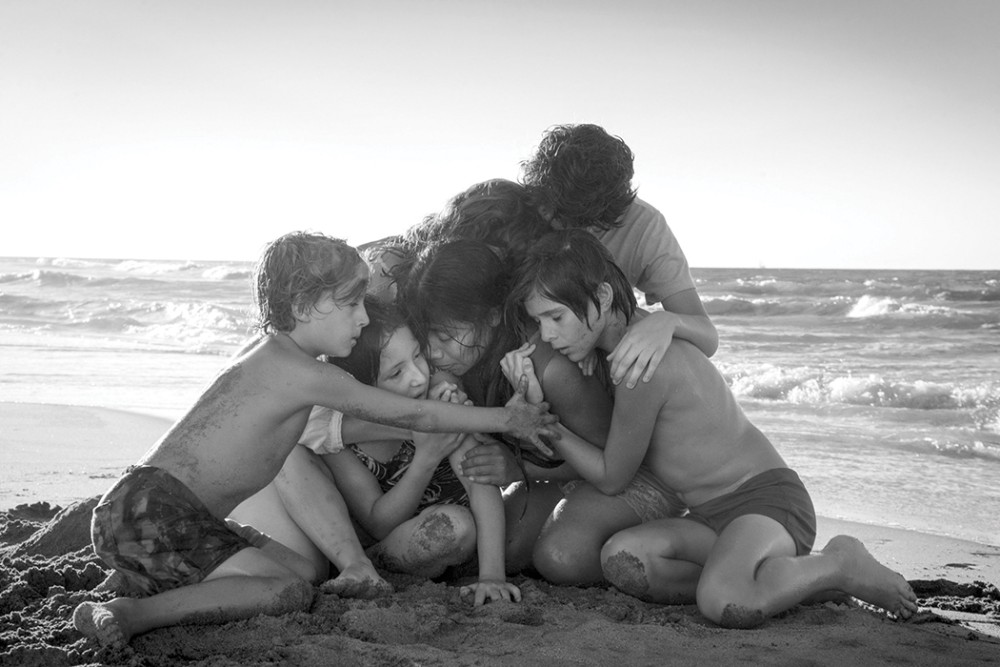In Roma, Alfonso Cuarón portrays life amid Mexico’s class divides
In Cuarón’s film, both love and violence come in waves.

The opening scene of Alfonso Cuarón’s breathtaking Spanish-language film Roma is of a large metal drain in the center of a tiled floor as gentle waves crested with soap suds wash over it. The waves build in strength until they finally subside and disappear through the grate. At the climax of the film, waves return, this time in the ocean, threatening to subsume the characters in their wake. This parallel set of images displays the film’s ambition to intertwine domestic and world-historical issues in a story about human connection after the devastations of colonial rule.
Roma is a domestic drama about one household in an upper-middle-class neighborhood in Mexico City in the early 1970s. The main character is Cleo (Yalitza Aparicio), a Mixtec woman whose labor keeps the household running. The story is based on Cuarón’s childhood and his memories of his family’s caretaker, Libo Rodriguez, who served as a consultant for the film.
Read our latest issue or browse back issues.
Drains and gates and other liminal spaces dominate the landscape of the movie, which was shot on wide-format black-and-white film. The effect of these filming techniques invest even the smallest details with grandeur. The water drain in the opening shot sits in the center of the tiled courtyard that serves as garage, dog pen, and children’s play space. The courtyard lies between the outside world and the house itself, and is the passage between the sprawling casa and the cramped domestic quarters Cleo shares with the other maid, Adela (Nancy García García). The soapy waves are created by Cleo’s never-ending battle with the mounds of dog shit that litter the courtyard. The large metal gates between the courtyard and the street demand enormous effort to be opened and closed. Cleo’s job, literally and metaphorically, is to keep the shit at bay and to know when and how to open and close the gates.
The shit prevails, and the gates are porous. There are adulterous affairs, an unexpected pregnancy that results in a traumatic birth, and political violence that spills out of the streets into the home.
Cleo is the one who ties the story together, but the movie is not about her in a traditional sense. We do not have privileged access to her inner life. We are never told how she ended up far from home, working around the clock to raise other people’s children, or if she wants to leave, or whom she left behind. When we do see her emotional reactions to the events of her life—the undeserved anger of her boss, the betrayal of a lover—they are not interpreted for us. We do not know how she unites these experiences and feelings into a unified story of her life. In a profound sense, she remains mysterious.
The film’s reticence to speak for Cleo is connected to its larger themes of national and colonial history. When Cleo speaks Mixtec with Adela, the children chide her for being incomprehensible. Allusions are made to land seizures that affect the people in Cleo’s home region. And Cleo’s first boyfriend is a member of los halcones (the hawks), a group of young men from poor regions who were trained and employed as a militia in the notorious Corpus Christi massacre of 1971, in which hundreds of democratic student protesters were killed. These allusions are reminders of the long history that created the conditions by which a Mixtec woman might find herself raising white Spanish children and sleeping with a militant being trained by a Mexican dictatorship and the CIA.
Having broken through the haze of childhood memory, Cuarón knows that those forces of power—and the race, class, and gender dynamics they set in motion—define the complex intimate relationships between domestic workers and their employers. But he does not want to stop at this acknowledgment. In the climactic scenes, where domestic waves are transformed into ocean waves, he suggests that real love can still be forged despite these entanglements. That scene is the only moment in the film in which Cleo gives voice to her inner life. As she confesses a feeling we’ve only been able to guess at, she is folded into the family in a powerful scene of oceanic embrace. For a fleeting moment, the constraints of class and history are transcended and a bond of love is affirmed.
This film could have dissolved into a sentimental love story of the worst kind: the white boy secures the pure love of his brown nanny through the power of his art. Cuarón resists this sentimentalizing by refusing to imagine he can speak for Cleo. But he also imagines that within a violent, oppressive world, human love is sometimes possible. Cuarón invests the full power of his art in offering us this mystery intact.
A version of this article appears in the print edition under the title “Life amid Mexico’s class divides.”







